Blog
Blog
Caring for Foot Wounds
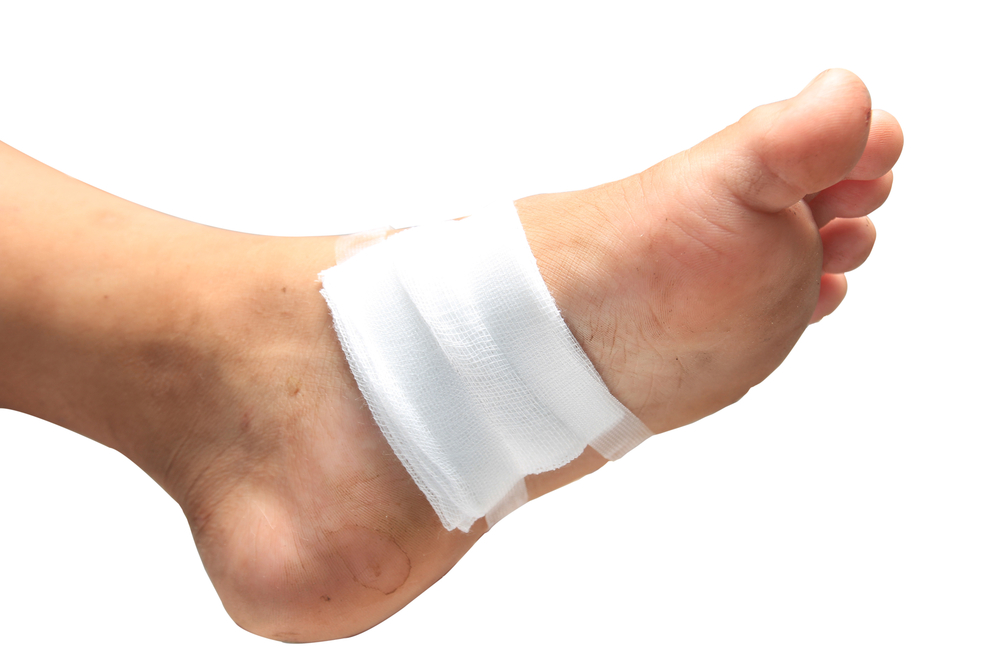 Our feet endure pressure during the majority of the day. It is important to promptly treat existing cuts or bruises on the feet, as this may be helpful in preventing foot wounds from developing. Patients who may be susceptible to developing wounds on the feet can include people who are diabetic or have medical conditions consisting of elevated cholesterol and blood pressure. It is beneficial to wear shoes and socks that are comfortable, in addition to trimming the toenails properly. A wound on the foot will heal faster when treated quickly, and it is strongly advised that you speak with a podiatrist who can effectively treat foot wounds.
Our feet endure pressure during the majority of the day. It is important to promptly treat existing cuts or bruises on the feet, as this may be helpful in preventing foot wounds from developing. Patients who may be susceptible to developing wounds on the feet can include people who are diabetic or have medical conditions consisting of elevated cholesterol and blood pressure. It is beneficial to wear shoes and socks that are comfortable, in addition to trimming the toenails properly. A wound on the foot will heal faster when treated quickly, and it is strongly advised that you speak with a podiatrist who can effectively treat foot wounds.
Wound care is an important part in dealing with diabetes. If you have diabetes and a foot wound or would like more information about wound care for diabetics, consult with one of our podiatrists from Port Richmond Family Footcare. Our doctors will assess your condition and provide you with quality foot and ankle treatment.
What Is Wound Care?
Wound care is the practice of taking proper care of a wound. This can range from the smallest to the largest of wounds. While everyone can benefit from proper wound care, it is much more important for diabetics. Diabetics often suffer from poor blood circulation which causes wounds to heal much slower than they would in a non-diabetic.
What Is the Importance of Wound Care?
While it may not seem apparent with small ulcers on the foot, for diabetics, any size ulcer can become infected. Diabetics often also suffer from neuropathy, or nerve loss. This means they might not even feel when they have an ulcer on their foot. If the wound becomes severely infected, amputation may be necessary. Therefore, it is of the upmost importance to properly care for any and all foot wounds.
How to Care for Wounds
The best way to care for foot wounds is to prevent them. For diabetics, this means daily inspections of the feet for any signs of abnormalities or ulcers. It is also recommended to see a podiatrist several times a year for a foot inspection. If you do have an ulcer, run the wound under water to clear dirt from the wound; then apply antibiotic ointment to the wound and cover with a bandage. Bandages should be changed daily and keeping pressure off the wound is smart. It is advised to see a podiatrist, who can keep an eye on it.
If you have any questions, please feel free to contact our office located in Lumberton, NJ, . We offer the newest diagnostic and treatment technologies for all your foot care needs.
Eating Properly While Pursuing Running
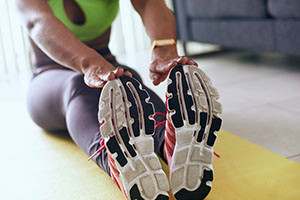 Many runners understand the importance of listening to the body, especially in the case of trying to prevent an injury as a result of overuse. Runners who are new to this sport can become injured from running excess miles in the beginning. Additionally, injuries can happen from running at accelerated speeds. It is helpful to drink plenty of water during the day, get an adequate amount of rest, and eat foods that are rich in nutrients. People who enjoy the sport of running often alternate going for a run with cardiovascular exercises, which can include cycling and swimming. If you would like more information about how to prevent running injuries, and how they can impact the feet, please consult with a podiatrist.
Many runners understand the importance of listening to the body, especially in the case of trying to prevent an injury as a result of overuse. Runners who are new to this sport can become injured from running excess miles in the beginning. Additionally, injuries can happen from running at accelerated speeds. It is helpful to drink plenty of water during the day, get an adequate amount of rest, and eat foods that are rich in nutrients. People who enjoy the sport of running often alternate going for a run with cardiovascular exercises, which can include cycling and swimming. If you would like more information about how to prevent running injuries, and how they can impact the feet, please consult with a podiatrist.
Exercising your feet regularly with the proper foot wear is a great way to prevent injuries. If you have any concerns about your feet, contact one of our podiatrists of Port Richmond Family Footcare. Our doctors will treat your foot and ankle needs.
How to Prevent Running Injuries
Many common running injuries are caused by overuse and overtraining. When the back of the kneecap starts wearing out and starts causing pain in your knee, this is commonly referred to as runner’s knee. Runner’s knee is a decrease in strength in your quadriceps and can occur if you’re not wearing properly fitted or supporting shoes. To prevent runner’s knee, focusing on hip strengthening is a good idea, as well as strengthening your quads to keep the kneecaps aligned.
What Are Some Causes of Running Injuries?
- One cause of a common running injury is called iliotibial band syndrome.
- Plantar fasciitis is also another common injury.
- Stress fractures can occur from overtraining, lack of calcium, or even your running style.
Best Ways to Prevent Running Injuries
- Wear footwear that fits properly and suits your running needs.
- Running shoes are the only protective gear that runners have to safeguard them from injury.
- Make a training schedule. Adding strengthening exercises as well as regular stretching can help keep you strong and limber and can lessen the possibility of injuries.
- Stretching keeps muscles limber; this will help you gain better flexibility.
If you have any questions please feel free to contact our office located in Lumberton, NJ, . We offer the newest diagnostic and treatment technologies for all your foot and ankle needs.
What is Tarsal Tunnel Syndrome?
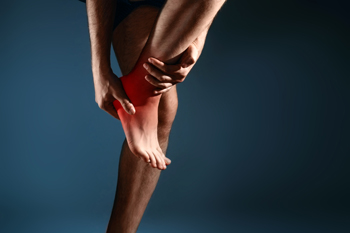 The Tarsal Tunnel is a narrow opening in the ankle that leads arteries, veins, tendons, and nerves to the foot. Tarsal Tunnel Syndrome occurs when the tibial nerve is squeezed anywhere along this tunnel. While flat feet lead to a higher risk of Tarsal Tunnel Syndrome, an injury, diabetes, or an abnormal structure like a bone growth, can all lead to the compression or squeezing of the nerve. Symptoms are usually felt in the ankle or bottom of the foot and include a tingling or burning sensation, numbness, and shooting pain. In order to prevent permanent damage to the nerve, it is important to have Tarsal Tunnel Syndrome diagnosed by a podiatrist as soon as possible. A podiatrist will be able to diagnose the extent of the injury and determine the best course of treatment that may include surgery, therapy, orthotic devices, or simply rest.
The Tarsal Tunnel is a narrow opening in the ankle that leads arteries, veins, tendons, and nerves to the foot. Tarsal Tunnel Syndrome occurs when the tibial nerve is squeezed anywhere along this tunnel. While flat feet lead to a higher risk of Tarsal Tunnel Syndrome, an injury, diabetes, or an abnormal structure like a bone growth, can all lead to the compression or squeezing of the nerve. Symptoms are usually felt in the ankle or bottom of the foot and include a tingling or burning sensation, numbness, and shooting pain. In order to prevent permanent damage to the nerve, it is important to have Tarsal Tunnel Syndrome diagnosed by a podiatrist as soon as possible. A podiatrist will be able to diagnose the extent of the injury and determine the best course of treatment that may include surgery, therapy, orthotic devices, or simply rest.
Tarsal tunnel syndrome can be very uncomfortable to live with. If you are experiencing tarsal tunnel syndrome, contact one of our podiatrists of Port Richmond Family Footcare. Our doctors can provide the care you need to keep you pain-free and on your feet.
Tarsal Tunnel Syndrome
Tarsal tunnel syndrome, which can also be called tibial nerve dysfunction, is an uncommon condition of misfiring peripheral nerves in the foot. The tibial nerve is the peripheral nerve in the leg responsible for sensation and movement of the foot and calf muscles. In tarsal tunnel syndrome, the tibial nerve is damaged, causing problems with movement and feeling in the foot of the affected leg.
Common Cause of Tarsal Tunnel Syndrome
- Involves pressure or an injury, direct pressure on the tibial nerve for an extended period of time, sometimes caused by other body structures close by or near the knee.
- Diseases that damage nerves, including diabetes, may cause tarsal tunnel syndrome.
- At times, tarsal tunnel syndrome can appear without an obvious cause in some cases.
The Effects of Tarsal Tunnel Syndrome
- Different sensations, an afflicted person may experience pain, tingling, burning or other unusual sensations in the foot of the affected leg.
- The foot muscles, toes and ankle become weaker, and curling your toes or flexing your foot can become difficult.
- If condition worsens, infections and ulcers may develop on the foot that is experiencing the syndrome.
A physical exam of the leg can help identify the presence of tarsal tunnel syndrome. Medical tests, such as a nerve biopsy, are also used to diagnose the condition. Patients may receive physical therapy and prescriptive medication. In extreme cases, some may require surgery.
If you have any questions please feel free to contact our office located in Lumberton, NJ, . We offer the newest diagnostic and treatment technologies for all your foot and ankle needs.
Barefoot Sports May Lead to Ankle Injuries
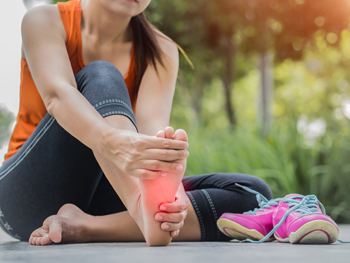 There are several sports that are played without wearing shoes. These can include beach volleyball, gymnastics, and specific types of martial arts. Foot and ankle injuries may be common among athletes who choose to participate in sports that do not require wearing shoes. Research has indicated that bruises and wounds to the feet may be a common occurrence. The most common type of injury experienced by gymnasts are ankle sprains. This can be a result of pulled muscles, and possible injuries to the bone. If you would like additional information about how to treat foot injuries that occur as a result of participating in sports, it is advised that you consult with a podiatrist.
There are several sports that are played without wearing shoes. These can include beach volleyball, gymnastics, and specific types of martial arts. Foot and ankle injuries may be common among athletes who choose to participate in sports that do not require wearing shoes. Research has indicated that bruises and wounds to the feet may be a common occurrence. The most common type of injury experienced by gymnasts are ankle sprains. This can be a result of pulled muscles, and possible injuries to the bone. If you would like additional information about how to treat foot injuries that occur as a result of participating in sports, it is advised that you consult with a podiatrist.
Sports related foot and ankle injuries require proper treatment before players can go back to their regular routines. For more information, contact one of our podiatrists of Port Richmond Family Footcare. Our doctors can provide the care you need to keep you pain-free and on your feet.
Sports Related Foot and Ankle Injuries
Foot and ankle injuries are a common occurrence when it comes to athletes of any sport. While many athletes dismiss the initial aches and pains, the truth is that ignoring potential foot and ankle injuries can lead to serious problems. As athletes continue to place pressure and strain the area further, a mild injury can turn into something as serious as a rupture and may lead to a permanent disability. There are many factors that contribute to sports related foot and ankle injuries, which include failure to warm up properly, not providing support or wearing bad footwear. Common injuries and conditions athletes face, including:
- Plantar Fasciitis
- Plantar Fasciosis
- Achilles Tendinitis
- Achilles Tendon Rupture
- Ankle Sprains
Sports related injuries are commonly treated using the RICE method. This includes rest, applying ice to the injured area, compression and elevating the ankle. More serious sprains and injuries may require surgery, which could include arthroscopic and reconstructive surgery. Rehabilitation and therapy may also be required in order to get any recovering athlete to become fully functional again. Any unusual aches and pains an athlete sustains must be evaluated by a licensed, reputable medical professional.
If you have any questions please feel free to contact our office located in Lumberton, NJ, . We offer the newest diagnostic and treatment technologies for all your foot and ankle needs.
Types Of Corns On The Feet
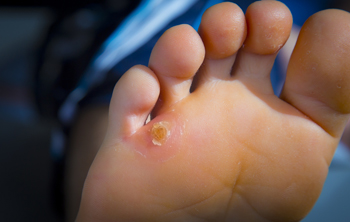 A corn can cause severe discomfort while wearing shoes. There are two types of corns that can develop on the feet. Soft corns are generally found between the toes, and can occur from wearing shoes that do not have adequate room for the toes to move freely in. Hard corns are located on the sole of the foot, or on top of the toes, and can develop from excessive friction. Mild relief may be found when a protective pad is placed over the corn, and it is beneficial to wear shoes that fit correctly. Corns on the feet can cause your walking style to be altered, which naturally compensates for the pain and discomfort that is associated with corns. If you are afflicted with a corn on your foot, please consult with a podiatrist who can offer correct treatment techniques.
A corn can cause severe discomfort while wearing shoes. There are two types of corns that can develop on the feet. Soft corns are generally found between the toes, and can occur from wearing shoes that do not have adequate room for the toes to move freely in. Hard corns are located on the sole of the foot, or on top of the toes, and can develop from excessive friction. Mild relief may be found when a protective pad is placed over the corn, and it is beneficial to wear shoes that fit correctly. Corns on the feet can cause your walking style to be altered, which naturally compensates for the pain and discomfort that is associated with corns. If you are afflicted with a corn on your foot, please consult with a podiatrist who can offer correct treatment techniques.
If you have any concerns regarding your feet and ankles, contact one of our podiatrists of Port Richmond Family Footcare. Our doctors will treat your foot and ankle needs.
Corns: What Are They? and How Do You Get Rid of Them?
Corns can be described as areas of the skin that have thickened to the point of becoming painful or irritating. They are often layers and layers of the skin that have become dry and rough, and are normally smaller than calluses.
Ways to Prevent Corns
There are many ways to get rid of painful corns such as wearing:
- Well-fitting socks
- Comfortable shoes that are not tight around your foot
- Shoes that offer support
Treating Corns
Treatment of corns involves removing the dead skin that has built up in the specific area of the foot. Consult with Our doctors to determine the best treatment option for your case of corns.
If you have any questions please feel free to contact our office located in Lumberton, NJ, . We offer the newest diagnostic and treatment technologies for all your foot and ankle needs.
Reminder: When Was the Last Time...?
Reasons Blisters Can Develop on the Feet
 Blisters on the feet can hinder a runner’s ability to enjoy the sport. They typically develop as a result of excess friction, and from shoes that do not fit correctly. Common areas for blisters to develop can include the arch, heel, and the sole of the foot. A blister is the body’s natural process to heal the area that has become damaged. It is defined as a small bubble that is filled with liquid, and this protects the raw area as new skin forms. It can be covered with a bandage until it gradually drains. Additional reasons why blisters may develop can consist of medical conditions such as psoriasis and eczema, frostbite, or allergic reactions. If you desire more information about blisters on the feet, please schedule a consultation with a podiatrist.
Blisters on the feet can hinder a runner’s ability to enjoy the sport. They typically develop as a result of excess friction, and from shoes that do not fit correctly. Common areas for blisters to develop can include the arch, heel, and the sole of the foot. A blister is the body’s natural process to heal the area that has become damaged. It is defined as a small bubble that is filled with liquid, and this protects the raw area as new skin forms. It can be covered with a bandage until it gradually drains. Additional reasons why blisters may develop can consist of medical conditions such as psoriasis and eczema, frostbite, or allergic reactions. If you desire more information about blisters on the feet, please schedule a consultation with a podiatrist.
Blisters are prone to making everyday activities extremely uncomfortable. If your feet are hurting, contact one of our podiatrists of Port Richmond Family Footcare. Our doctors can provide the care you need to keep you pain-free and on your feet.
Foot Blisters
Foot blisters develop as a result of constantly wearing tight or ill-fitting footwear. This happens due to the constant rubbing from the shoe, which can often lead to pain.
What Are Foot Blisters?
A foot blister is a small fluid-filled pocket that forms on the upper-most layer of the skin. Blisters are filled with clear fluid and can lead to blood drainage or pus if the area becomes infected.
How Do Blisters Form?
Blisters on the feet are often the result of constant friction of skin and material, usually by shoe rubbing. Walking in sandals, boots, or shoes that don’t fit properly for long periods of time can result in a blister. Having consistent foot moisture and humidity can easily lead to blister formation.
Prevention & Treatment
It is important to properly care for the affected area in order to prevent infection and ease the pain. Do not lance the blister and use a Band-Aid to provide pain relief. Also, be sure to keep your feet dry and wear proper fitting shoes. If you see blood or pus in a blister, seek assistance from a podiatrist.
If you have any questions, please feel free to contact our office located in Lumberton, NJ, . We offer the newest diagnostic and treatment technologies for all your foot care needs.
Understanding the Basics of Stress Fractures
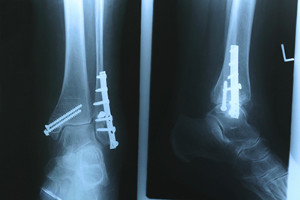 Stress fractures primarily occur when the feet are overused. As foot muscles get tired, they are unable to absorb as much shock from impact, and the stress is transferred to the bone. Over half of all stress fractures occur in the lower leg, and athletes involved in activities such as basketball, running, and gymnastics are at a higher risk for trauma. Since stress fractures can be difficult to diagnose through an X-Ray, communicating the risk of stress fractures to doctors is key, because they may have to resort to CT scans or MRIs. If diagnosed with a stress factor, rest is key. However, a podiatrist may be able to recommend shoe inserts or braces to help as well. For the best treatment methods, please consult with your local podiatrist.
Stress fractures primarily occur when the feet are overused. As foot muscles get tired, they are unable to absorb as much shock from impact, and the stress is transferred to the bone. Over half of all stress fractures occur in the lower leg, and athletes involved in activities such as basketball, running, and gymnastics are at a higher risk for trauma. Since stress fractures can be difficult to diagnose through an X-Ray, communicating the risk of stress fractures to doctors is key, because they may have to resort to CT scans or MRIs. If diagnosed with a stress factor, rest is key. However, a podiatrist may be able to recommend shoe inserts or braces to help as well. For the best treatment methods, please consult with your local podiatrist.
Activities where too much pressure is put on the feet can cause stress fractures. To learn more, contact one of our podiatrists from Port Richmond Family Footcare. Our doctors can provide the care you need to keep your pain free and on your feet.
Dealing with Stress Fractures of the Foot and Ankle
Stress fractures occur in the foot and ankle when muscles in these areas weaken from too much or too little use. The feet and ankles then lose support when walking or running from the impact of the ground. Since there is no protection, the bones receive the full impact of each step. Stress on the feet can cause cracks to form in the bones, thus creating stress fractures.
What Are Stress Fractures?
Stress fractures occur frequently in individuals whose daily activities cause great impact on the feet and ankles. Stress factors are most common among:
- Runners
- People affected with Osteoporosis
- Tennis or basketball players
- Gymnasts
- High impact workouts
Symptoms
Pain from the fractures occur in the area of the fractures and can be constant or intermittent. It will often cause sharp or dull pain with swelling and tenderness. Engaging in any kind of activity which involves high impact will aggravate pain.
If you have any questions please feel free to contact our office located in Lumberton, NJ, . We offer the newest diagnostic and treatment technologies for all your foot and ankle needs.
Heel Pain May Be Common Among Overweight Patients
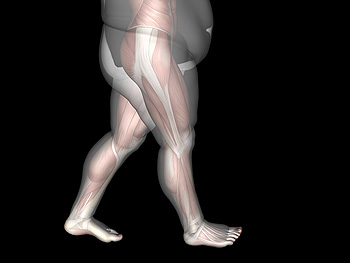 Obesity affects a large percentage of people worldwide. The additional weight the feet endure can lead to the development of painful foot conditions. Heel pain is a common ailment, and it can be indicative of specific foot complications. These can include plantar fasciitis, flat feet, or different types of arthritis. Many people who are overweight are faced with the dilemma of lacking the desire to exercise. Performing frequent stretches and exercises is beneficial to losing weight, despite that it may be difficult to accomplish. If you have gained weight and have frequent heel pain, it is recommended that you are under the care of a podiatrist who can properly diagnose you and help to manage your weight.
Obesity affects a large percentage of people worldwide. The additional weight the feet endure can lead to the development of painful foot conditions. Heel pain is a common ailment, and it can be indicative of specific foot complications. These can include plantar fasciitis, flat feet, or different types of arthritis. Many people who are overweight are faced with the dilemma of lacking the desire to exercise. Performing frequent stretches and exercises is beneficial to losing weight, despite that it may be difficult to accomplish. If you have gained weight and have frequent heel pain, it is recommended that you are under the care of a podiatrist who can properly diagnose you and help to manage your weight.
The more you weigh, the harder your feet must work to support your body. If you’re an obese individual and are concerned about your feet, contact one of our podiatrists from Port Richmond Family Footcare. Our doctors can provide the care you need to keep you pain-free and on your feet.
Obesity and Your Feet
People who are overweight are putting more pressure on their ankles, knees, and hips as well as their feet. This unfortunately can lead to variety of different issues.
Problems & Complications Stemming from Obesity
- When the body is overweight, it tries to compensate by changing the way that it moves. An obese person may lean forward and put extra weight on the wrong part of the foot. This puts unnecessary stress on the feet.
- Obese people are also more likely to develop type II diabetes which is a condition that causes a lot of foot problems. People with diabetes often don’t feel the cuts and sores that they may have on their feet, which can lead to more complicated and severe issues.
- Plantar fasciitis is another foot condition that can be caused by obesity. Plantar fasciitis is an inflammation of the tissue along the bottom of the foot, which causes pain and stiffness while walking and climbing stairs.
If you have any questions, please feel free to contact our office located in Lumberton, NJ, . We offer the newest diagnostic and treatment technologies for all your foot care needs.
Three Phases of Wound Healing
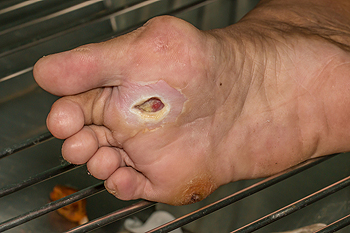 Patients who have wounds on their feet may experience difficulty in walking, in addition to having severe pain and discomfort. Chronic foot wounds can occur for a variety of reasons. These may include having diabetes, recovery from surgery, or if there has been a severe burn. Research has indicated there are three phases of the healing process. The first stage is referred to as the inflammatory phase in which the blood vessels naturally constrict to form a clot. This is followed by the fibroblastic stage that allows the protein source that is referred to as collagen to help the wound to heal and close. The last stage is known as the maturation phase, and as the wound continues to heal, it will typically form a scar. If you would like additional information about foot wounds, it is suggested that you speak with a podiatrist.
Patients who have wounds on their feet may experience difficulty in walking, in addition to having severe pain and discomfort. Chronic foot wounds can occur for a variety of reasons. These may include having diabetes, recovery from surgery, or if there has been a severe burn. Research has indicated there are three phases of the healing process. The first stage is referred to as the inflammatory phase in which the blood vessels naturally constrict to form a clot. This is followed by the fibroblastic stage that allows the protein source that is referred to as collagen to help the wound to heal and close. The last stage is known as the maturation phase, and as the wound continues to heal, it will typically form a scar. If you would like additional information about foot wounds, it is suggested that you speak with a podiatrist.
Wound care is an important part in dealing with diabetes. If you have diabetes and a foot wound or would like more information about wound care for diabetics, consult with one of our podiatrists from Port Richmond Family Footcare. Our doctors will assess your condition and provide you with quality foot and ankle treatment.
What Is Wound Care?
Wound care is the practice of taking proper care of a wound. This can range from the smallest to the largest of wounds. While everyone can benefit from proper wound care, it is much more important for diabetics. Diabetics often suffer from poor blood circulation which causes wounds to heal much slower than they would in a non-diabetic.
What Is the Importance of Wound Care?
While it may not seem apparent with small ulcers on the foot, for diabetics, any size ulcer can become infected. Diabetics often also suffer from neuropathy, or nerve loss. This means they might not even feel when they have an ulcer on their foot. If the wound becomes severely infected, amputation may be necessary. Therefore, it is of the upmost importance to properly care for any and all foot wounds.
How to Care for Wounds
The best way to care for foot wounds is to prevent them. For diabetics, this means daily inspections of the feet for any signs of abnormalities or ulcers. It is also recommended to see a podiatrist several times a year for a foot inspection. If you do have an ulcer, run the wound under water to clear dirt from the wound; then apply antibiotic ointment to the wound and cover with a bandage. Bandages should be changed daily and keeping pressure off the wound is smart. It is advised to see a podiatrist, who can keep an eye on it.
If you have any questions, please feel free to contact our office located in Lumberton, NJ, . We offer the newest diagnostic and treatment technologies for all your foot care needs.





